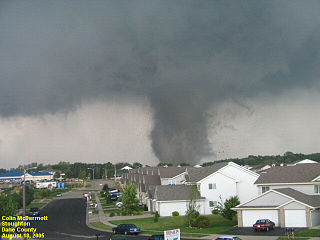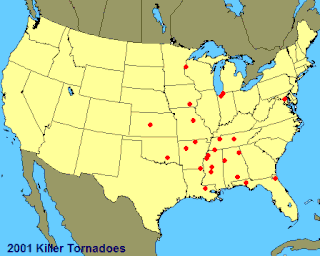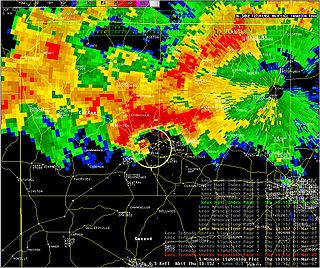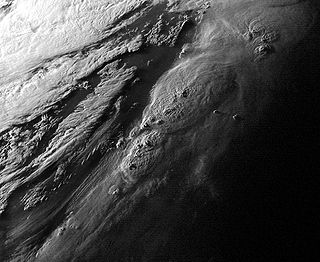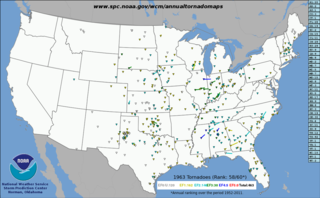| List of confirmed tornadoes – Sunday, April 2, 2006 |
|---|
| F# | Location | County | Time (UTC) | Path length | Damage |
| Iowa |
| F0 | SW of Bloomfield | Davis | 2047 | unknown | Brief touchdown over open fields with no damage. [11] |
| F0 | N of Pulaski | Davis | 2057 | unknown | Brief "pencil-thin" tornado remained over open fields with no damage. [12] |
| F2 | W of Pittsburg | Van Buren | 2101 | 3 miles
(5 km) | Two houses lost their roofs and four outbuildings were destroyed. Many trees and power lines were downed as well. [13] |
| F1 | N of Mount Zion | Van Buren | 2109 | 2.5 miles
(4 km) | A roof was blown off a barn with minor roof damage to a house. Several outbuildings were destroyed with tree damage noted. [14] |
| F1 | S of Fairfield | Jefferson | 2118 | unknown | Brief tornado touchdown destroyed an outbuilding. [15] |
| F1 | E of Stockport | Van Buren | 2119 | 3 miles
(5 km) | Several outbuildings were destroyed and numerous trees were knocked down. [16] |
| F2 | Washington | Washington | 2147 | 1 mile
(1.6 km) | Tornado struck the west side of town. A garage was completely unroofed and a shed was destroyed. Numerous trees were snapped along the path, and metal sheeting was torn off a business near the end of the path. [17] |
| F1 | S of Riverside | Washington | 2200 | unknown | Power lines were knocked down by this brief tornado. [18] |
| F0 | SW of Hartford | Warren | 2206 | unknown | Brief tornado remained over open fields with no damage. [19] |
| F0 | N of Runnells | Polk | 2231 | unknown | Brief tornado remained over open fields with no damage. [20] |
| Missouri |
| F2 | NE of Perry to SE of Hatch | Ralls | 2125 | 3.2 miles
(5 km) | Near Clarence Cannon Dam, a convenience store sustained minor damage, a pole barn was destroyed and scattered, and two boats were flipped over. An RV dealership was badly damaged, sustaining collapse of its service bay, and with only one wall left standing on the second floor. At least 30 campers sustained some type of damage, and 8 to 10 of them were completely destroyed. Some of the camper frames were found 150 to 200 feet north of their initial positions, and debris from this area was scattered over 1/4 mile away. Three 1x3 inch boards were found stuck in the dealerships hard packed gravel lot. Further along the path, a pole barn was damaged, many trees were snapped, and a metal sign was stuck 4–6 inches into a tilled field. [21] |
| F0 | Park Hills | St. Francois | 2200 | 150 yd
(130 m) | Caused minor damage to the roofs of three houses and an auto business. Numerous tree limbs were also snapped. [22] |
| F0 | SW of Weingarten | Ste. Genevieve | 2205 | 2 miles
(3.2 km) | Three farms sustained minor home and machine shed damage, while several trees were snapped or uprooted. [23] |
| F0 | N of Sikeston | Scott | 2343 | 2 miles
(3.2 km) | Several buildings on a farm sustained minor damage, along with the roof of a house. [24] |
| Arkansas |
| F1 | SW of Williford to E of Ravenden | Sharp, Lawrence | 2159 | 10 miles
(16 km) | In Sharp County, a barn and a workshop were damaged, and many trees were snapped or uprooted. In Lawrence County, up to 40 homes were damaged. In the town of Ravenden, a barn, a rental house, and 4 unoccupied buildings were damaged. [25] |
| F3 | S of Pocahontas, AR to Caruthersville, MO | Randolph (AR), Greene (AR), Dunklin (MO), Pemiscot (MO) | 2237 | 77 miles
(124 km) | 2 deaths – See section on this tornado . |
| F2 | SE of Armstrong Springs to N of Searcy | White | 2235 | 6.3 miles
(10 km) | Tornado destroyed two mobile homes, and several other mobile homes were damaged. A self-storage warehouse was damaged as were three other businesses. Several dozen trees were uprooted, and power lines were downed. A number of vehicles were badly damaged as well. [26] |
| F3 | SE of Morton to W of Crawfordsville | Woodruff, Cross, Crittenden | 2352 | 22 miles
(35 km) | In Woodruff County, the tornado was at F0 intensity, with limited to trees and power lines. In Cross County, the tornado reached F3 intensity and struck the small community of Fitzgerald Crossing, where 10 homes were destroyed or had major damage, with 27 homes and 5 mobile homes receiving minor damage. Village Creek State Park sustained damage to its visitor's center and tennis court. Two buildings sustained minor damage in Crittenden County, before the tornado dissipated. Many trees were snapped and uprooted along the path, and 5 people were injured. [27] |
| Illinois |
| F1 | S of Blandinsville | McDonough | 2214 | 12 miles
(20 km) | A maintenance garage, two wooden barns, a metal pole barn, and 7 grain bins were destroyed. 4 grain bins were damaged, and extensive tree damage occurred as well. [28] |
| F0 | NE of Piasa | Macoupin | 2215 | 2 miles
(3.2 km) | A mobile home was destroyed, and a grain bin and some farm buildings were damaged. [29] |
| F0 | Piasa | Macoupin | 2215 | 0.5 mile
(800 m) | Numerous homes in town sustained roof and siding damage, and extensive tree and power line damage occurred. A barn was destroyed, a parking canopy collapsed, and a car was pushed off of a road. [30] |
| F2 | Fairview Heights/O'Fallon areas | St. Clair | 2215 | unknown | 1 death – A clothing store sustained collapse of its roof, and a church sustained roof and steeple damage. Numerous homes were damaged, some heavily. One home had its roof torn off and thrown 100 yards. Many trees and power lines were downed as well, and 11 people were injured. [31] |
| F0 | N of Terre Haute | Henderson | 2218 | unknown | Brief touchdown caused no damage. [32] |
| F0 | S of Dorsey to SW of Staunton | Madison, Macoupin | 2220 | 16 miles
(26 km) | Near Dorsey, trees were damaged and roof shingles were blown off of a couple of homes. Damage to trees, power lines, and shingles occurred near Staunton as well. [33] |
| F1 | SW of Highland | Madison | 2230 | 2 miles
(3.2 km) | A garage and a machine shed were destroyed, and homes sustained roof, window, and siding damage. Power poles were snapped as well. [34] |
| F0 | N of Gillespie | Macoupin | 2235 | 100 yd
(90 m) | One mobile home was destroyed. [35] |
| F0 | N of Walshville | Montgomery | 2241 | 1 mile
(1.6 km) | Damaged limited to a single farm, where a house suffered minor roof damage and a shed was destroyed. Some trees were downed as well. [36] |
| F1 | SW of Loami | Sangamon | 2246 | 0.5 mile
(800 m) | Several large trees and some power lines were downed. [37] |
| F1 | NE of Berlin | Sangamon | 2249 | 2 miles
(3.2 km) | A grain bin and a pole barn were destroyed, and another pole barn was damaged. Trees were snapped as well. [38] |
| F2 | Hillsboro to E of Nokomis | Montgomery | 2250 | 20 miles
(32 km) | In Hillsboro, two gas stations and a car dealership sustained window and sign damage. Metal sheeting was blown into trees as well. East of town, several barns were destroyed, with debris scattered up to a mile away. Grain bins and machine sheds were also heavily damaged, and two high-tension truss towers were toppled. [39] |
| F1 | N of Chatham | Sangamon | 2256 | 1 mile
(1.6 km) | Several homes sustained roof damage. [40] |
| F1 | E of Farmersville to NW of Morrisonville | Montgomery, Christian | 2256 | 3 miles
(5 km) | Several outbuildings, grain bins, and barns were heavily damaged at three farms. [41] |
| F1 | Springfield (1st tornado) | Sangamon | 2258 | 1 mile
(1.6 km) | Damage reported in the same area hit on March 12, with minor roof and structural damage to several businesses. |
| F0 | SW of Pawnee | Sangamon | 2259 | 1.3 miles
(2 km) | Three grain bins were overturned and destroyed, and three barns were also damaged. Trees were downed as well. [42] |
| F1 | Springfield (2nd tornado) | Sangamon | 2306 | 0.75 mile
(1.2 mile) | Fourth and final tornado to strike Springfield in 2006. The Illinois Department of Transportation building sustained roof damage. [43] |
| F1 | Taylorville | Christian | 2308 | 6.3 miles
(10 km) | Multiple homes and businesses in town sustained roof and structural damage. Sheds were damaged and numerous trees were downed as well. One person was injured. [44] |
| F1 | S of Riverton | Sangamon | 2313 | 1.5 miles
(2.4 mile) | Tornado struck a mobile home park, destroying 8 homes and damaging 30 others. Numerous trees were blown down and one person was injured. [45] |
| F1 | N of Oconee to Pana | Shelby, Christian | 2315 | 6 miles
(9.5 km) | A shed had its roof torn off and another shed was blown across a field. In Pana, many trees were downed and homes sustained roof damage. [46] |
| F0 | NE of Taylorville | Christian | 2317 | unknown | Brief touchdown in an open field with no damage. [47] |
| F1 | Assumption | Christian | 2320 | 1 miles
(1.6 km) | Minor roof and tree damage occurred in town. [48] |
| F0 | Greenview | Menard | 2322 | 0.25 mile
(400 m) | A house sustained minor siding damage. [49] |
| F0 | E of Niantic | Macon | 2330 | 0.1 mile
(150 m) | Brief touchdown in an open field with no damage. [49] |
| F2 | SW of Macon | Macon | 2330 | 4.5 miles
(7.5 km) | One large barn was destroyed with debris scattered up to a mile away. A house sustained minor roof damage as well. [50] |
| F0 | SE of Lincoln | Logan | 2332 | 1 miles
(1.6 km) | Tornado damaged a barn, blew down a large tree, and damaged a grain storage bin. [51] |
| F0 | NW of Chestnut | Logan | 2336 | 2.5 miles
(4 km) | Tornado caused roof damage to several barns, blew down a few trees, and damaged shingles on homes. [52] |
| F1 | SW of Elwin to S of Decatur | Macon | 2336 | 7.5 miles
(11.5 km) | Tornado snapped power poles and blew down numerous trees along its path. It damaged the roof of several structures and broke a window and some signs at a strip mall. Three people were injured by flying glass. [53] |
| F0 | Neoga | Cumberland | 2342 | 0.75 mile
(1.2 km) | The roof was damaged at a local school, plus several trees were knocked down. [54] |
| F0 | N of Weldon | De Witt | 0001 | 0.1 mile
(150 m) | Tornado remained in open fields with no damage. [55] |
| F0 | S of Towanda | McLean | 0008 | 0.1 mile
(150 m) | Tornado remained in open fields with no damage. [56] |
| F0 | S of Arrowsmith | McLean, Woodford | 0012 | 0.5 mile
(800 m) | A barn was destroyed, and another barn had its metal roof torn off. Three concrete grain silos were destroyed as well. [57] |
| F0 | Champaign area | Champaign | 0015 | 0.1 mile
(150 m) | Brief touchdown with no damage. [58] |
| F0 | SW of Saybrook | McLean, Livingston | 0022 | 2.25 miles
(3.5 km) | Tornado remained over open fields with no damage. [59] |
| F0 | Flatville | Champaign | 0025 | 0.25 mile
(400 m) | Minor structural damage occurred in town. [60] |
| Tennessee |
| F3 | N of Lenox to E of Newbern | Dyer, Gibson | 0030 | 18 miles
(29 km) | 16 deaths – This devastating tornado affected rural areas before it struck the north edge of Newbern, where major damage occurred. 71 homes were destroyed and 182 others were damaged. Some frail homes were swept completely away. 70 people were injured. [61] |
| F3 | W of Dyer to S of McKenzie | Gibson, Weakley, Carroll | 0109 | 31 miles
(50 km) | 6 deaths – Tornado touched down and caused some damage in Dyer before rapidly intensifying and striking Bradford. Bradford was severely damaged, with 75 homes destroyed and 250 others damaged. The police station was destroyed, and several businesses were heavily damaged. The tornado then passed near Pillowville, with 4 homes destroyed and 38 others damaged in that area. Two barns were destroyed as well. South of McKenzie, 34 homes, two apartments, one shop building, and 9 farm buildings were damaged. A church and some grain bins were also destroyed before the tornado dissipated. 44 people were injured, and many trees and power lines were downed along the path. All fatalities occurred in Bradford. [62] |
| F3 | N of Rutherford | Gibson | 0125 | 10 miles
(16 km) | 2 deaths – 6 homes were destroyed and 250 others were damaged. Vehicles were picked up and thrown into fields. 6 people were injured. [63] |
| F1 | Longtown area | Fayette | 0245 | 1 mile
(1.6 km) | Ten homes and two businesses were damaged, along with many barns and outbuildings. Numerous trees and power lines were downed and two people were injured. [64] |
| F1 | SW of Camden | Benton | 0255 | unknown | A trucking company was completely destroyed, with debris scattered up to 2 miles away. [65] |
| F2 | W of Brownsville | Haywood | 0325 | 0.75 mile
(1.2 km) | Considerable damage occurred in the Hickory Mills subdivision. 24 homes sustained roof damage, and one was destroyed. Another home was moved off of its foundation. [66] |
| Kentucky |
| F0 | E of Gage | McCracken | 0031 | unknown | Tornado remained over open country with no damage. [67] |
| F3 | N of Hopkinsville | Christian, Todd | 0150 | 30 miles
(48 km) | Large wedge tornado. In Christian County, 91 homes were destroyed and 171 others were damaged. Numerous garages, barns, and outbuildings were destroyed, and some vehicles were damaged or destroyed as well. Hundreds of trees were downed, snapped, or uprooted, and several metal high-tension towers were toppled, cutting off power to Hopkinsville for 6 hours. In Todd County, 2 homes were destroyed and 28 others were damaged. Close to two dozen sheds and barns were damaged or destroyed, along with at least one grain bin. Numerous trees were uprooted, and some farm machinery and vehicles were damaged or destroyed, including tractors and combines. A church had its roof torn off and its windows blown out in Cedar Grove before the tornado dissipated. Gas leaks were reported in the area, and 28 people were injured. [68] |
| F1 | N of Shelbyville | Shelby | 0215 | 2 miles
(3.2 km) | Anticyclonic tornado damaged trees and power lines. [69] |
| F1 | SE of Edwards | Logan | 0330 | 2 miles
(3.2 km) | Unknown minor damage occurred. [70] |
| Indiana |
| F1 | Mitchell | Lawrence | 0105 | unknown | A few homes and businesses were damaged in town. [71] |
| F1 | SE of Romney | Tippecanoe | 0110 | unknown | Minor damage occurred, mostly to outbuildings. [72] |
| F1 | Seymour | Jackson | 0145 | unknown | Minor to moderate damage to several houses in town. Numerous trees and power lines also knocked down. [73] |
| Sources: SPC Storm Reports for 04/02, Little Rock office, Quad Cities office, Memphis office, Paducah office, Lincoln office, Nashville office, Indianapolis office, Louisville office, National Climatic Data Center |








